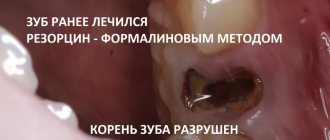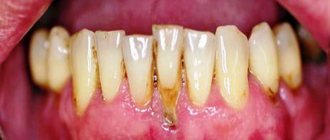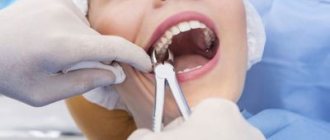From this article you will learn:
- in what cases is tooth resection performed?
- photo and video of the operation,
- tooth root resection: patient reviews, price 2022.
The article was written by a dental surgeon with more than 19 years of experience.
Root apex resection is a surgical method for treating granulomas and cysts that form at the root apex due to chronic inflammation (caused by infection in the root canals of the tooth). Granulomas and cysts are subtypes of a disease called chronic periodontitis.
They differ from each other only in size... If the inflammation at the root apex is more than 1 cm in diameter, the formation is called a radicular cyst, and if it is less than 1 cm, it is called a granuloma or cystogranuloma. Visually, they look like a “bag of pus” attached to the top of the tooth root.
Thus, the main indications for resection are the presence of an inflammatory focus at the apex of the tooth root, which is difficult to cure using conservative treatment methods for chronic periodontitis. The latter consists of temporarily filling the root canals with preparations based on calcium hydroxide (for a period of 2-3 months).
When is it necessary to remove a tooth root?
In all cases, the doctor decides individually whether the situation requires tooth root removal after carrying out diagnostic measures and examination using radiography or visiography. Among the most common indications for tooth root removal are the following:
- the patient suffers from aching and throbbing pain in the tooth;
- in the peri-root area there is some swelling of the gums;
- there are signs of inflammation;
- the root of the tooth is destroyed;
- third degree of tooth root mobility;
- tooth fracture is of increased complexity;
- the level at which the destruction of the dental crown is located is located below the level of the gums;
- a cyst was diagnosed.
If the rotting tooth root is not removed in a timely manner, it can give rise to a serious infectious process in the oral cavity, as well as bad breath. Problems will certainly affect healthy tissues nearby.
In some cases, even in the presence of inflammation and severe tooth decay, you can do without root removal. This will allow, after carrying out the necessary therapeutic measures, to restore or build up the tooth. The final decision on this issue is made by the dentist.
Tooth root removal: painful or not?
Most often, the situation in which tooth root removal is indicated occurs when the pulp is dead. To avoid pain and discomfort, the “Optimal Choice” dental clinics use modern high-quality local anesthesia before tooth root removal and other manipulations. Therefore, you should not be afraid of pain and put off visiting the dentist for the indefinite future. Today the procedure takes place with a minimum of discomfort.
Types of deletion
To remove a tooth root, your dentist may use one of the following methods:
- tongs;
- using an elevator;
- using a drill.
Tooth root removal using forceps is most often used. For the upper roots, tools with straight ends are best, and for the lower roots, beak-shaped models are best. Bayonet pliers are universal and are suitable for all cases. If the tooth is single-rooted, then the rotation method, that is, rotation, is suitable for root removal. If a tooth has several roots, luxation is required.
If the roots are located far away, it may not be possible to remove them with forceps. Then various elevators are used, which operate on a principle similar to levers. The root is twisted out using this tool, and part of it appears on the surface. After this, it is already possible to remove it using forceps. Elevators come in corner and bayonet types. The former give good results on the roots of the lower teeth and their remains, while the latter are often used to remove “figure eights”.
If there are some peculiarities in the location of the roots or their strong “ingrowth” into the bone, the dentist will need a drill. The procedure can take quite a long time and requires high professionalism, however, like all types of medical care. Depending on the severity of the problem, removal surgery may be performed using one of the following methods:
- root hemisection—one of the roots of the tooth is removed;
- root extraction - it is completely removed.
Alternatives to tooth resection –
Resection in most cases is not mandatory and is the only method of treating granulomas and cysts.
Mandatory resection is required only in the presence of large cysts (for example, 1.5-2 cm or more). The latter is due to the fact that the shell of large cysts is very dense and thick, and does not completely disappear even with good conservative treatment (although the cyst itself decreases in size). Therapeutic treatment of cysts is carried out by a dentist, and the only drawback of this method is the duration of therapy and a slightly larger number of visits to the doctor. In order for the granuloma/cyst to begin to shrink and disappear, it is necessary to completely neutralize the source of infection in the root canals, and then seal the root canals with a medicinal paste based on calcium hydroxide for a period of several months.
After a few months, the doctor will take an x-ray of you to see how much the cyst has shrunk, and if everything is fine, he will prescribe you for permanent root canal filling. Until this moment, you will walk with a temporary filling. It should be noted that conservative treatment is not always effective, and the tooth becomes inflamed over and over again. Therefore, it is sometimes easier to immediately fill the root canal on a permanent basis, and the next day carry out an operation to remove the cyst.
Stages of the procedure
First, the dentist must conduct a diagnostic examination, examining the root of the tooth and the patient’s oral cavity. Particular attention is paid to the condition of the gums and the presence of inflammation. A survey and medical history allows you to choose the best method of anesthesia that will not cause an allergic reaction.
Then the doctor, based on the condition of the tooth root, selects the extraction method and prepares the instrument to be used.
An injection with an anesthetic is made into the gum in the area of the affected tooth root, and further procedures to remove the root using the chosen method are carried out after the anesthesia has taken effect.
After the tooth root is removed, the oral cavity is treated with an antiseptic, then an anti-inflammatory agent is applied to the treated area. If an incision was made in the gums, it is necessary to apply sutures. They are removed after a week. After tooth root removal, the patient is prescribed analgesics and antibiotics.
Contraindications
This list looks like this:
- serious somatic diseases (diabetes mellitus, malignant tumors, pathologies of the cardiovascular system, etc.);
- the need to preserve root canals;
- obstruction of root canals;
- root fusion;
- bone resorption;
- elderly age.
Along with this, performing root hemisection should not cause damage to adjacent teeth. Another important point is the possibility of allergic reactions in the body. We are talking about the rejection of the artificial material with which the root canal is filled. Such situations are very rare, but they cannot be discounted categorically. Otherwise, the postoperative period will be significantly delayed and will bring serious complications.
Possible complications
Among the most common complications that occur during tooth root removal are the following:
- dislocation of the jaw, if the doctor has little experience;
- inflammatory process in the hole;
- penetration of bone particles into it;
- damage to teeth located next to the one being removed;
- allergy to anesthesia;
- heavy bleeding.
If you do not skimp on dental services and contact an experienced specialist, as well as follow all medical recommendations, then the risk of complications is minimized.
Get a consultation
We will answer all your questions before visiting the clinic!
+7
Online registration
Content
1 The difference between atraumatic tooth extraction and conventional
2 Advantages of atraumatic tooth extraction
3 Indications for atraumatic tooth extraction
4 Stages of atraumatic tooth extraction 4.1 Comprehensive diagnostics
4.2 Preparation of membrane from plasma
4.3 Removal with a piezo scalpel and periotome
4.4 Application of blood plasma membrane
5 Disadvantages of piezosurgery for tooth extraction
6 Dental implantation immediately after extraction
7 Prices for atraumatic tooth extraction
Preventive actions
The main prevention of possible complications after tooth root removal is the patient’s compliance with all recommendations given by the dentist. These include:
- after the operation, you need to press the gauze swab tightly against the hole for 15-20 minutes and then remove it;
- During the day, it is necessary to treat the fresh wound very carefully so as not to disturb the formed clot. For example, you will have to give up mechanical teeth cleaning;
- for five hours after surgical removal of the tooth root, you should stop drinking hot foods and eating;
To avoid inflammation, you should contact your dentist again at the slightest suspicion.
Rehabilitation period
After the procedure, the patient may feel pain. Painkillers prescribed by your doctor will help reduce it. It is also necessary to strictly follow all the dentist’s recommendations to make the healing process faster, take prescribed medications, and carefully observe oral hygiene. For three days after surgery, it is strictly forbidden to rinse your mouth.
For the first time after surgery, you can eat only soft foods, trying not to injure the damaged area. It will be important to stop smoking tobacco and drinking alcoholic beverages.
It is recommended to exclude baths, saunas, and not take hot baths for several days. If you heat the procedure site, bleeding may begin. If this does happen, it is necessary to apply a cold, wet cloth or ice, which will constrict the blood vessels and quickly stop the bleeding.
Experts' opinion
Question: After removing the root, the doctor told me to rinse my mouth. What means can be used for this?
Answer : Among the most accessible means for rinsing the mouth after tooth root removal are: a weak salt solution (you can use a mixture of salt and baking soda in equal proportions), miramistin, chlorhexidine, a weak solution of potassium permanganate (light pink), a decoction or infusion of medicinal products herbs (chamomile, sage, eucalyptus, calendula). Oak bark helps very well. It must be remembered that active rinsing cannot be carried out on the first day after surgery. During this period, you just need to put the product in your mouth and hold it for a few minutes, then spit it out.
Question: Is it possible to remove a tooth root yourself at home?
Answer : Doctors at the Optimal Choice dental clinics recommend that you never try to remove a tooth root at home on your own, but if you have the slightest problem with your teeth, visit a dentist as soon as possible. It is not worth saving on your health, since such savings may entail large expenses in the future. At home, it is not possible to painlessly, efficiently and correctly remove the root of a tooth using improvised means. This can only be done in a clinical setting.
FAQ
• Is it painful to remove a tooth?
Painless tooth extraction using local anesthetics is carried out by absolutely all dental clinics. But if “freezing” is not enough, then it is better to go to a private clinic that provides all types of pain relief.
• How do you know when a tooth needs to be removed?
If it is very loose or the crown is completely destroyed, then most likely it will be removed. In other cases, accurate diagnosis is necessary.
• Is it possible to have a tooth removed if you have a cold?
Surgical intervention is unacceptable in the presence of an acute infection, including acute respiratory infections or influenza. This is due to the high probability of infection of injured tissues.
• Is it possible to remove a tooth if you have sinusitis?
The operation is not performed during exacerbation of the disease.











